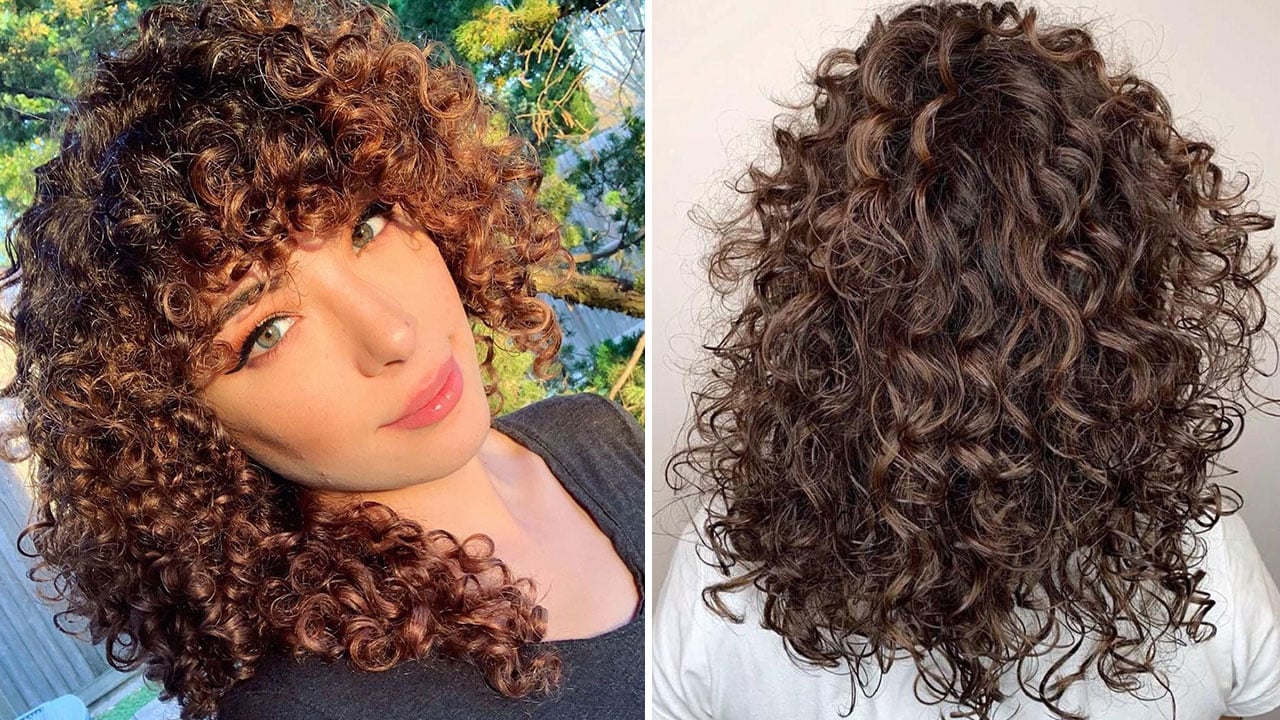Have you ever dreamt of sporting both bouncy curls and vibrant hues? The allure of permed, colored hair is undeniable, but the question that often lingers is: can you perm and color your hair simultaneously? It’s a common concern, especially for those wanting to experiment with a more dramatic look without multiple salon visits.

Image: www.pinterest.com.mx
This article delves into the complexities of perming and coloring hair, exploring the potential benefits, drawbacks, and safety considerations. We’ll equip you with the knowledge to make informed decisions about your hair transformation, ensuring a successful and healthy outcome.
The Science Behind Perming and Coloring
Understanding Perming
Perming, short for permanent waving, alters the hair’s structure to create curls or waves. It utilizes chemicals, typically containing thioglycolate, to break down the disulfide bonds within the hair shafts. These bonds, responsible for the hair’s straightness, are then reformed in a new pattern, resulting in curls or waves.
Unraveling Hair Coloring
Hair coloring, on the other hand, focuses on changing the hair’s color. It involves using dye molecules that penetrate the hair shaft and deposit pigments onto the cortex, the hair’s inner layer. Coloring can be permanent, semi-permanent, or temporary, depending on the type of dye used and its interaction with the hair’s natural pigment.

Image: nenyanavjodh.blogspot.com
The Potential Pitfalls of Simultaneous Treatments
Chemical Interactions: A Double-Edged Sword
The crux of the matter lies in the chemical interactions between perming and coloring solutions. While seemingly disparate, these treatments share common chemical components, including ammonia and peroxide, which can lead to unforeseen consequences if applied together:
- Weakened Hair: Simultaneous perming and coloring can excessively strain the hair, leaving it fragile, brittle, and prone to breakage.
- Uneven Color Results: The perming solution might alter the hair’s porosity, making it difficult for the color to penetrate evenly. The result could be uneven or patchy color distribution.
- Unexpected Color Changes: The chemicals used in perming could affect the color’s shade, leading to unexpected results, such as a color that’s lighter or darker than intended.
- Potential for Damage: The harsh chemicals can lead to extensive damage, including dryness, frizz, and even hair loss in extreme cases.
When It Might Be Acceptable: Navigating the Exceptions
While simultaneous perming and coloring is generally discouraged, there are a few scenarios where it might be feasible:
1. Professional Expertise: The Key to Success
The most critical factor is to seek out an experienced and qualified stylist. A skilled professional can assess your hair’s condition, choose appropriate products, and carefully manage the application process to minimize the risks.
2. Carefully Selecting Products: Matching is Crucial
Opting for products specifically designed for simultaneous perming and coloring minimizes the chances of adverse reactions. These treatments are formulated to work in harmony, minimizing damage and ensuring predictable results.
3. Prioritizing Hair Health: The Foundation of Success
Ensuring your hair is healthy before any chemical treatments is vital. This involves following a hair care routine that promotes hydration and strength. A healthy foundation, combined with proper aftercare, minimizes the risk of damage and maximizes the chances of achieving your desired look.
Alternatives For a Multi-faceted Hair Transformation
If the prospect of combined treatments seems risky, consider alternative approaches to achieving your desired look while minimizing the stress on your hair:
1. Spacing Out Treatments: A Safer Solution
Perming and coloring separately, with a gap of a few weeks between each treatment, allows your hair to recover and minimizes the risk of chemical overload. This approach offers greater control and allows you to refine your desired style.
2. Temporary Solutions: Exploring the Palette
For those seeking a less permanent solution, temporary coloring techniques using hair chalks, sprays, or toners offer a gateway to experimentation without the commitment or potential damage of permanent dyes.
3. Heat Styling: Embracing Alternatives
For those seeking curls without perming, heat styling tools like curling irons or hot rollers offer a versatile way to achieve different curl patterns and styles. This approach provides flexibility and control over your hair’s look without the harsh chemicals associated with perming.
Managing Post-Treatment Hair Care: Protecting Your Investment
Regardless of whether you choose simultaneous or separate treatments, prioritizing post-treatment hair care is essential to maintain the health and vibrancy of your hair. This involves:
1. Regular Deep Conditioning: Nourishing From Within
Deep conditioning treatments are vital to address the dryness and damage that chemical treatments often cause. Look for products rich in moisturizing ingredients like argan oil, shea butter, and keratin to restore your hair’s moisture balance and promote shine.
2. Gentle Shampoos and Conditioners: Minimizing Stripping
Switch to gentle, sulfate-free shampoos and conditioners that are designed to cleanse without stripping your hair of natural oils. These products help maintain moisture and prevent further damage.
3. Heat Protection: A Shield Against Damage
Heat styling tools like curling irons, blow dryers, and straighteners can further damage hair that has already undergone chemical treatments. Invest in heat protectant sprays or serums to create a barrier against heat damage and preserve your style.
Can You Perm And Color Your Hair
Conclusion: Empowering Your Hair Journey
Perming and coloring your hair simultaneously can be a risky proposition, but it’s not impossible with careful planning and professional guidance. Understanding the potential drawbacks and alternatives allows you to make informed decisions that prioritize your hair’s health and help you achieve your desired look. Remember that investing in regular deep conditioning, gentle hair care, and heat protection is crucial after any chemical treatment to maintain your hair’s vibrancy and prevent future damage. Your hair journey is a personal one, and with the right knowledge and choices, you can create a style that reflects your unique personality and enhances your natural beauty.





